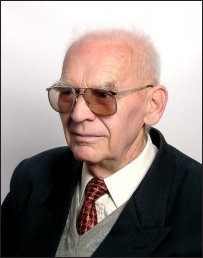 Stanisław Gorgolewski. (Photo courtesy of the Gorgolewski family)
Stanisław Gorgolewski. (Photo courtesy of the Gorgolewski family)
Stanisław Gorgolewski
Contributed by Richard Wielebinski and Andrzej Kus
Stanisław Gorgolewski was born on 19th October 1926 in Słonin (presently Byalorus) and died in Toruń on 23rd April 2011. Professor 'Stan' Gorgolewski was the driving force for the establishment of observational radio astronomy at the Nicolaus Copernicus University (NCU) in Toruń, Poland.
During the war years (1941-1945) Gorgolewski become a forced laborer. After the war (1945-1948) he finished his schooling while working as a technician in a radio workshop. Finally he was able to study, in the years 1948-1952, in the Adam Mickiewicz University (AMU) in Poznań. In 1953 he became involved in many instrumental projects making detectors for cosmic rays and electronics for carbon dating at the Physics Department of AMU. By the end of 1953 Stan (as he was known) moved to the Nicolaus Copernicus University in Toruń. In 1958 he was awarded a British Council Scholarship and went to Martin Ryles' group in Cambridge. He also collaborated with Anthony Hewish during this 15 month visit in Cambridge. Here Stan's interests changed to radio astronomy, solar radio emissions in particular. His Doctoral thesis, defended in 1960, was entitled "Observations of outer Solar corona using interferometric methods." He received the habilitation and docent degree (a prerequisite for a University career) in 1964 presenting his own original work "Radio observations of solar super corona in 1961-1963."
In the following years, with the support of Prof. W. Iwanowska, Stan continued his solar studies. He constructed several interferometers (up to 1.4 km baseline) for low frequencies (32 MHz) and dreamt of building a big radio telescope system. At first he wanted to construct a larger interferometer but had more success in the construction of several single dishes. At first, without approval of the director, he organized the construction of a 12m dish. This antenna was incorporated in an international Solar monitoring program. Through Stan's initiative and hard work the Radio Astronomy Group became established as separate entity in the Astronomy Department. The political situation in Poland was less restrictive than in other Eastern Europe countries allowing Stan and his co-workers to travel to international institutes. These visits led to active participation in technical developments and often returning radio astronomers came back with electronic elements needed for the construction of receivers.
The 500th anniversary of the birth of Copernicus in 1973 was taken as an opportunity to expand radio astronomy activities in Poland. Stan Gorgolewski became involved in the "Interkosmos-Kopernik 500" satellite project, a prestigious USSR space project, contributing a solar spectrometer for hectometer wavelength. In addition Stan saw an opportunity to improve radio astronomy and became very active in proposing a large building for his radio astronomy group in the observatory grounds in Piwnice (near Toruń) and a new large radio instrument (five 25m antennas interferometer). Due to financial problems the realization of his ambitious concepts for radio astronomy were delayed. Only the construction of the radio astronomy observatory buildings in Piwnice was completed on time in September 1973 - a few days before the special IAU Copernicus 500th anniversary meeting. In 1970 he became a Full Professor at the NCU.
A 15m diameter radio telescope was completed in 1977. This telescope made the first VLBI observations with the Effelsberg 100m radio telescope in 1982, a step to become a member of the European VLBI Consortium. A VLBI MkIIC terminal and the receiving systems were build under Stan's direct guidance by the team of his radio observatory. In 1984 Toruń joined the global VLBI network, a long-time dream of Stan Gorgolewski. Through Stan's further political activity a 32 m radio telescope was completed in 1994, the present main instrument of the Toruń Radio Astronomy Observatory.
Stan was a very jovial person, dedicated to his work. He was very active all the time to develop radio astronomy in Poland. In addition to the hardware in the form of buildings and radio telescopes, Stan supervised numerous students. He was a talented lecturer and a very open and friendly person. He was active in supporting young people to make international contacts. He himself also fostered his international contacts mostly to bring back electronic elements not available locally. Stan was a member of many international committees in the IAU, URSI, ITU, CRAF and EVN. His presence at meetings of the European VLBI Consortium was always entertaining, with Stan's latest political jokes from behind the iron curtain. Stan died in 2011 at age 85 years.
![[IAU logo]](iau_wb_thumb.jpg)
![[URSI logo]](URSI-logo-thumb.jpg)
![[Karl Jansky at his antenna]](jansky_photo_02_thumb.jpg)
![[Reber's Wheaton antenna]](Reber_Telescope_Wheaton_thumb.jpg)
![[Dover Heights]](Dover_Heights_02_thumb.jpg)
![[4C telescope]](GB61-195_4C_telescope_thumb.jpg)
![[Ewen and horn antenna]](ewen_horn1s.jpg)
![[Dwingeloo, 1956]](Dwingeloo-1956-thumb.jpg)
![[Jocelyn Bell Burnell and Cambridge antenna used in pulsar discovery]](burnell2_thumb.jpg)
![[Lovell Telescope at Jodrell Bank]](site_1594_0001-500-334-20180316163019-thumb150.jpg)
![[Wilson, Penzias, and Bell Labs horn antenna]](wilson-penzias-horn_thumb.jpg)
![[6-m Millimeter Radio Telescope in Mitaka, Japan]](6m-thumb.jpg)

